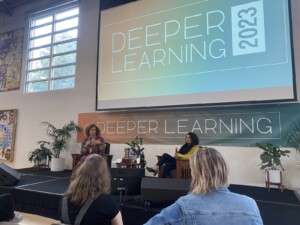Teaching with Comics

Have you ever used a comic strip in class? Have you ever turned to a comic for your own education? (If you’ve ever read the flight safety pamphlet on a plane, the answer to that question is “yes.”)
Despite their historical reputation as “low brow” non-literature (they were even blamed for juvenile delinquency back in the ‘50s) comics have proven useful for everything from motivating kids to read to instructional manuals for the military. Comics combine visual language with written language (although there are some wordless comic) in ways no other medium can.
As Scott McCloud writes in Understanding Comics (highly recommended), “The medium we call comics is based on a simple idea: The idea of placing one picture after another to show passage of time. The potential of that idea is limitless, but perpetually obscured by its limited application in popular culture.”
Comics have come a long way since the invention of Spandex-wearing crime-fighters. Even if you consider many well-known comics (such as Spider-Man, the X-Men, or Superman) unsuitable for yourself or your students due to portrayals of violence or scantily-clad women, plenty of other high quality comics exist that can be used to teach reading, English language learning, and science.
Nor are comics limited in their appeal to children (or young men with power fantasies). Many comics exist that can appeal to a broad range of ages, interests, and genders. Since the 1970s, American comics have flourished as an art form, producing award-winning “serious” comics such Art Spiegelman’s Maus and quirky thoughtful works like Daniel Clowes’ Ghost World. European comics were historically more diverse and often higher-quality (in terms of art and story craft) than American comics; in addition to drama, fantasy, and detective books (including classics like The Adventures of Tintin), many European comic book series are historical fictions.
Over the next few weeks, I’ll be exploring the use of comics* for education in and out of the classroom, starting next week with language arts.
In the mean time, check out some of these great resources:
- Make Beliefs Comix (makebeliefscomix.com): Anyone can create 3-panel comics — in 7 different languages! — with this free online app (also available in the Apple App Store). You can also download free “printables” for some pencil-and-paper comic creation.
- If you’re looking for some fancier comic-creation software, you might try Pixton (pixton.com). It’s not free, but teachers do get a free trial.
- The Comic Book Project (comicbookproject.org) is a “world-renowned literacy initiative that engages young people in the process of planning, writing, designing, and publishing original comic books.”
- Get an idea of the amazing variety of comics available by sampling some (free and amazing) webcomics: autobiographical comics by Lucy Knisley and Sarah Becan, somber post-apocalyptic It Will All Hurt, adorable Gronk and Simon’s Cat, and the strange, fun, and un-self-conscious Dinosaur Comics.
* For the purposes of this series, I’ll use the term “comics” to refer to single-panel comics, comic strips, and graphic novels as well as “manga” (Japanese comic books) and BDs (French comic albums).







Amy Saunders
Oh, hi! After watching the entire season of Ms. Marvel last week, one of the youngsters in my neighborhood seems interested to learn more about comic strips. You presented a solid argument by proving to us that such mediums can be used to enhance the level of creativity among kids nowadays. You know, I should call someone at an instant to help him master the art in no time. https://udderlyridiculousproductions.com/comic-strips